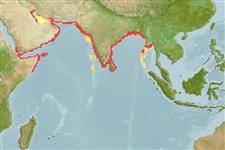>
Clupeiformes (Herrings) >
Dorosomatidae (Gizzard shads and sardinellas)
Etymology: Tenualosa: Latin, tenuis = thin + Latin, alausa = a fish cited by Ausonius and Latin, halec = pickle, dealing with the Greek word hals = salt; it is also the old Saxon name for shad = "alli" ; 1591 (Ref. 45335).
More on author: Hamilton.
Environment: milieu / climate zone / depth range / distribution range
ນິເວດວິທະຍາ
ສັດທະເລ; ນ້ຳຈືດ; ນ້ຳກ່ອຍ; ປາທີ່ມີການເຄື່ອນຍ້າຍຈາກທະເລ ແລະ ໄປໄຂ່ຢູ່ນ້ຳຈືດ (Ref. 127664); ລະດັບຄວາມເລິກ ? - 200 m. Tropical; 34°N - 5°N, 42°E - 97°E (Ref. 188)
Indian Ocean: Persian Gulf eastward to Myanmar, including western and eastern coasts of India. Reported from the Gulf of Tonkin, Viet Nam (Ref. 9706). Reported in Tigris River basin and probably other rivers of southern Iran (Ref. 39702).
Length at first maturity / ຂະໜາດ / ນ້ຳໜັກ / Age
Maturity: Lm 31.3, range 18 - ? cm
Max length : 60.0 cm SL ຕົວຜູ້/ບໍ່ມີເພດ; (Ref. 188); common length : 36.0 cm SL ຕົວຜູ້/ບໍ່ມີເພດ; (Ref. 4832); common length :42 cm TL (female); ນ້ຳໜັກສູງສຸດທີ່ເຄຍຈັດພີມມາ: 680.00 g (Ref. 4832); ນ້ຳໜັກສູງສຸດທີ່ເຄຍຈັດພີມມາ: 680.00 g; ອາຍຸສູງສຸດທີ່ເຄຍລາຍງານມາ: 5 ປີ (Ref. 43871)
ຄີ (ໜາມ)ແຂງຢູ່ຫຼັງປາ (ທັງໝົດ): 0; ຄີຫຼັງຂອງປາ (ຄີອ່ອນ) (ທັງໝົດ): 18-21; ຄີ(ໜາມ) ແຂງຢູ່ຄີກົ້ນປາ
ກຸ່ມປາກະດູກແຂງ
ຄວາມຖີ່ຂອງກຸ່ມຖ່າຍທອດພັນ
ປາທີ່ມີການເຄື່ອນຍ້າຍຈາກທະເລໄປຫານ້ຳຈືດ ແລະນ້ຳຈືດຫາທະເລ
ປາທີ່ມີການເຄື່ອນຍ້າຍຈາກທະເລແລະໄປໄຂ່ຢູ່ນ້ຳຈືດ
ຄີກົ້ນຂອງປາ
ສັດທີ່ມີກະດູກສັນຫັຼງ
ການຖ່າຍທອດທາງກຳມະພັນຈາກພໍ່ແມ່ຫາລູກ 0; ຄີກົ້ນຂອງປາ: 18 - 23. Belly with 30 to 33 scutes. Distinct median notch in upper jaw. Gill rakers fine and numerous, about 100 to 250 on lower part of arch. Fins hyaline. A dark blotch behind gill opening, followed by a series of small spots along flank in juveniles. Color in life, silver shot with gold and purple.
Schooling in coastal waters and ascending rivers for as much as 1200 km (usually 50-100 km). Migration though is sometimes restricted by barrages. Hilsa far up the Ganges and other large rivers seem to be permanent river populations. Feeds on plankton, mainly by filtering, but apparently also by grubbing on muddy bottoms. Breeds mainly in rivers during the southwest monsoon (also from January to February to March). Artificial propagation has been partially successful in India (Ref. 4832). Known to be a fast swimmer, covering 71 km in one day (Ref. 12203). Marketed fresh or dried-salted.
Breeds mainly in rivers, upstream to about 50 km or even over 1000 km as in the Ganges (younger fishes may breed in the tidal zone of rivers). In some rivers the migration is restricted by barrages; there is some evidence that hilsa far up the Ganges and other large rivers, although migrating upstream to spawn, are permanent river populations that do not descend to the sea. The main breeding season is during the southwest monsoon, with a shorter season from January to February or March.
Whitehead, P.J.P., 1985. FAO Species Catalogue. Vol. 7. Clupeoid fishes of the world (suborder Clupeoidei). An annotated and illustrated catalogue of the herrings, sardines, pilchards, sprats, shads, anchovies and wolf-herrings. FAO Fish. Synop. 125(7/1):1-303. Rome: FAO. (Ref. 188)
IUCN Red List Status (Ref. 130435)
Threat to humans
Harmless
Human uses
ການປະມົງ: ທີ່ເປັນການຄ້າໜ້ອຍ; ການລ້ຽງສັດນ້ຳ: ການທົດລອງ
ຂໍ້ມູນຕື່ມອີກ
ເອກະສານອ້າງອີງການລ້ຽງສັດນ້ຳຂໍ້ມູນການລ້ຽງສັດນ້ຳສາຍພັນກຳມະພັນElectrophoresesການຖ່າຍທອດທາງກຳມະພັນຈາກພໍ່ແມ່ຫາລູກພະຍາດການປຸງແຕ່ງNutrientsMass conversion
ເຄື່ອງມື
Special reports
Download XML
ແຫຼ່ງອີນເຕີເນັດ
Estimates based on models
Preferred temperature (Ref.
123201): 21.3 - 28, mean 24.7 °C (based on 224 cells).
Phylogenetic diversity index (Ref.
82804): PD
50 = 0.5312 [Uniqueness, from 0.5 = low to 2.0 = high].
Bayesian length-weight: a=0.00912 (0.00801 - 0.01039), b=3.03 (2.99 - 3.07), in cm total length, based on LWR estimates for this species (Ref.
93245).
ຊັ້ນເຂດຮ້ອນ (Ref.
69278): 2.9 ±0.29 se; based on food items.
ຄວາມຢືດຢຸ່ນ (Ref.
120179): ຂະໜາດກາງ, ປະຊາກອນຕຳ່ສຸດທີ່ໃຊ້ເວລາສອງເທົ່າ 1.4 - 4.4 ປີ (K=0.3-1.2; tmax=5; tm=2; Fec=220,000).
Prior r = 0.59, 95% CL = 0.39 - 0.89, Based on 4 stock assessments.
Fishing Vulnerability (Ref.
59153): Low to moderate vulnerability (29 of 100).
Climate Vulnerability (Ref.
125649): Very high vulnerability (84 of 100).
Nutrients (Ref.
124155): Calcium = 67.3 [52.4, 88.0] mg/100g; Iron = 2.07 [1.20, 3.36] mg/100g; Protein = 17 [16, 18] %; Omega3 = 0.619 [0.299, 1.262] g/100g; Selenium = 55 [24, 131] μg/100g; VitaminA = 16.3 [5.8, 45.1] μg/100g; Zinc = 1.09 [0.70, 1.79] mg/100g (wet weight); based on
nutrient studies.
